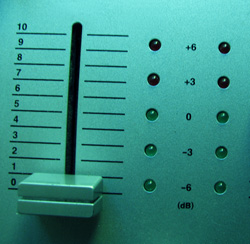
Now that we have thrown all of these numbers out there for you to ponder over, we now need to know when we would want to use these different input settings.
The primary factor in determining which settings to use is determined by the designer’s requirement for the system’s noise floor.
If noise floor is not absolutely critical (NC-25 or higher spaces), then the amplifiers can safely be set on 0.775 (or preferably 1.4V if available).
Because the actual gain of the amplifiers is quite high (~X40 for a 100 watt amp to ~X130 for a 2500 watt amp), the noise floor will be higher. The clear advantage, however, is that you do not need to calculate the attenuation needed for every channel of every amplifier.
If noise levels are a critical concern, then constant gain settings should be used, but you will need to calculate the attenuation for each amp channel.
To conclude our discussion on signal processing and the output level switches on DSP devices, if you are using an amplifier that has its input sensitivity set on 0.775V, then the output of the DSP should be set at 0 dB. This will provide 18 dB of attenuation between the console and the amplifiers.
If the input sensitivity of the amps are set at 1.4V, then the output of the DSP should be set at 6 dB. If you are using constant gain, then each output needs to be addressed on an individual basis.
One final note on gain structure worth mentioning is to always have a good sense for what is occurring with the system equalization. Let’s assume that there is a large +10 dB boost in the EQ at 8K.
During system tuning it may make the speakers sound very well and provide extended high end frequency response, but 8K signals will clip the amplifiers 10 dB sooner than the rest of the system.
Similar problems may arise from very large EQ cuts, but if at all possible, for gain structure purposes, it is better to cut than to boost, and it will always be best to keep your cuts and boosts to an absolute minimum.
Brian Elwell is senior consultant with Acoustic Dimensions and has contributed to system designs at major stadiums, houses of worship, theme parks and many other venues.
